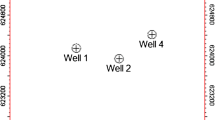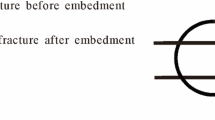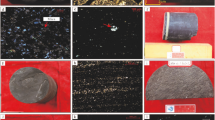Abstract
Evaluation of the gas shale mechanical properties is very important screening criteria for determining the potential intervals for hydraulic fracturing and as a result in gas shale sweet spot mapping. Young’s modulus and Poisson’s ratio are two controlling mechanical properties that dictate the brittleness of the gas shale layers. These parameters can be determined in the laboratory by testing the rock sample under different conditions (static method) or can be calculated using the well-logging data including sonic and density log data (dynamic method). This study investigates the importance of the shale composition and geochemical parameters on the Young’s modulus and Poisson’s ratio using log data. The data set of this study is coming from five different wells targeting the Kockatea Shale and Carynginia formation, two potential gas shale formations in the Perth Basin, Western Australia. The results show that converse to the common idea the effect of organic matter quantity and maturity on the rock mechanical properties of the gas shale reservoirs is not so much prominent, while the composition of the rock has an important effect on these properties. Considering the weight percentage of shale composition and organic matter quantity it could be concluded that effect of these parameters on rock mechanical properties is dependent on their weight contribution on the shale matrix. As well as effect of thermal maturity on the shale matrix and consequently on the rock mechanical properties of the shales is dependent on the organic matter content itself; therefore, obviously with a low organic matter content thermal maturity has no prominent effect on the brittleness as well.













Similar content being viewed by others
Abbreviations
- E :
-
Young’s modulus (GPa)
- V p :
-
Compressional wave velocity (km/s)
- V s :
-
Shear wave velocity (km/s)
- BI:
-
Brittleness index
- RMSE:
-
Root mean squared error
- ρ :
-
Bulk density (kg/m3)
- ν :
-
Poisson’s ratio
References
Cadman SJ, Pain L, Vuckovic V (1994) Australian petroleum accumulations report 10: Perth Basin, Western Australia. p 116
Castagna JP, Batzle ML, Kan TK (1993) Rock physics: the link between rock properties and AVO response. In: Castagna JP, Backus MM (eds) Offset-dependent reflectivity—theory and practice of AVO analysis: Investigations in Geophysics Series. Soc Expl Geophys 8:135–171
Castagna JP, Batzle ML, Eastwood RL (1985) Relationships between compressional-wave and shear-wave velocities in clastic silicate rocks. Geophysics 50:571–581
Grieser WV, Bray JM (2007) Identification of production potential in unconventional reservoirs. Production and operations symposium, Oklahoma, USA. SPE106623
Hornby BE, Schwartz LM, Hudson JA (1994) Anisotropic effective-medium modeling of the elastic properties of shales. Geophysics 59:1570–1583
Jarvie DM, Hill RJ, Ruble TE, Pollastro RM (2007) Unconventional shale-gas systems: the Mississippian Barnett Shale of north-central Texas as one model for thermogenic shale-gas assessment. AAPG Bulletin 91:475–499
Josh M, Esteban L, Piane CD, Sarout J, Dewhurst DN, Clennell MB (2012) Laboratory characterisation of shale properties. J Petrol Sci Eng 88–89:107–124
Labani MM, Rezaee R (2012) Thermal maturity estimation of gas shale layers from conventional well log data: a case study from Kockatea Shale and Carynginia formation of Perth Basin, Australia. SPE Asia Pacific oil and gas conference and exhibition, Perth, Australia. SPE158864
Jacobi DJ, Gladkikh M, LeCompte B, Hursan G, Mendez F, Long J, Ong S, Bratovich M, Patton GL, Shoemaker P (2008) Integrated petrophysical evaluation of shale gas reservoirs. CIPC/SPE gas technology symposium—joint conference, Alberta, Canada. SPE114925
Mondol NH, Jahren J, Bjørlykke K, Brevik I (2008) Elastic properties of clay minerals. Lead Edge 27:758–770
Passey QR, Creaney S, Kulla JB, Moretti FJ, Stroud JD (1990) A practical model for organic richness from porosity and resistivity logs. AAPG Bulletin 74:1777–1794
Passey QR, Bohacs K, Esch WL, Klimentidis R, Sinha S, (2010). From oil-prone source rock to gas-producing shale reservoir—geologic and petrophysical characterization of unconventional shale gas reservoirs. International oil and gas conference and exhibition in China. SPE131350
Pickett GR (1963) Acoustic character logs and their applications in formation evaluation. J Petrol Technol 15:650–667
Rickman R, Mullen MJ, Petre JE, Grieser WV, Kundert D (2008) A practical use of shale petrophysics for stimulation design optimization: all shale plays are not clones of the Barnett Shale. SPE annual technical conference and exhibition, Colorado, USA. SPE115258
Rider MH (1996) The geological interpretation of well logs. Whittles Publishing, p 280
Ross DJK, Bustin RM (2009) The importance of shale composition and pore structure upon gas storage potential of shale gas reservoirs. Mar Pet Geol 26:916–927
Slatt RM, Abousleiman Y (2011) Merging sequence stratigraphy and geomechanics for unconventional gas shales. Leading Edge 30:274–282
Thomas BM (1979) Geochemical analysis of hydrocarbon occurrences in northern Perth Basin, Australia. AAPG Bulletin 63:1092–1107
Vanorio T, Mukerji T, Mavko G (2008) Emerging methodologies to characterize the rock physics properties of organic-rich shales. Lead Edge 27:780–787
Vernik L, Liu X (1997) Velocity anisotropy in shales: a petrophyscial study. Geophysics 62:521–532
Vernik L, Milovac J (2011) Rock physics of organic shales. Lead Edge 30:318–323
Vernik L, Nur A (1992) Ultrasonic velocity and anisotropy of hydrocarbon source rocks. Geophysics 57:727–735
Vernik L, Fisher D, Bahret S (2002) Estimation of net-to-gross from P and S impedance in deepwater turbidites. Lead Edge 21:380–387
Wang Z (2001) Fundamentals of seismic rock physics. Geophysics 66:398–412
Wang FP, Gale JF (2009) Screening criteria for shale-gas systems. Gulf Coast Assoc Geol Soc Trans 59:779–793
Zhu Y, Liu E, Martinez A, Payne MA, Harris CE (2011) Understanding geophysical responses of shale-gas plays. Lead Edge 30:332–338
Acknowledgments
The authors would like to thank Curtin University Shale Gas Consortium sponsors; Western Australia Department of Mine and Petroleum, Buru Energy, Carnarvon Petroleum, Norwest Energy and Woodside; for financial support and permission to publish the results of this study.
Author information
Authors and Affiliations
Corresponding author
Rights and permissions
About this article
Cite this article
Labani, M.M., Rezaee, R. The Importance of Geochemical Parameters and Shale Composition on Rock Mechanical Properties of Gas Shale Reservoirs: a Case Study From the Kockatea Shale and Carynginia Formation From the Perth Basin, Western Australia. Rock Mech Rock Eng 48, 1249–1257 (2015). https://doi.org/10.1007/s00603-014-0617-6
Received:
Accepted:
Published:
Issue Date:
DOI: https://doi.org/10.1007/s00603-014-0617-6




